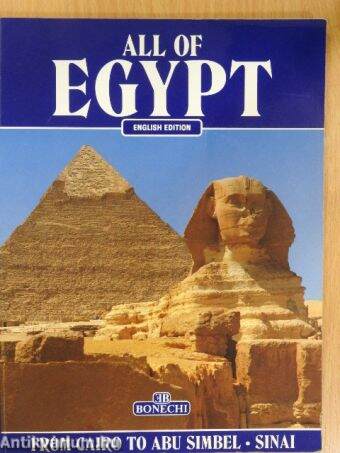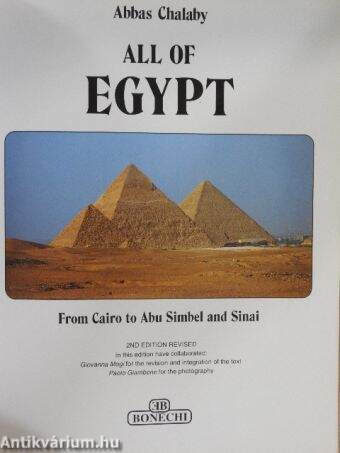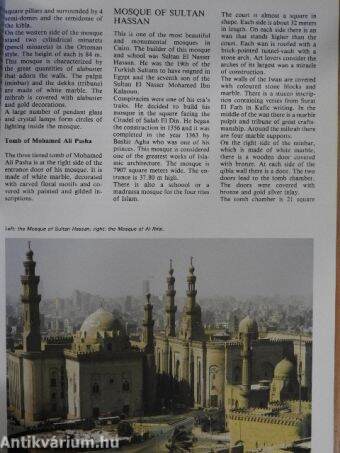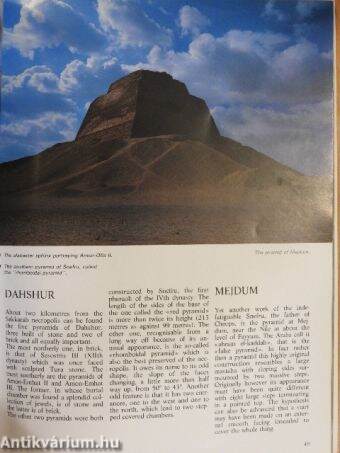1.114.866
kiadvánnyal nyújtjuk Magyarország legnagyobb antikvár könyv-kínálatát
All of Egypt
From Cairo to Abu Simbel and Sinai
| Kiadó: | Bonechi |
|---|---|
| Kiadás helye: | Firenze |
| Kiadás éve: | |
| Kötés típusa: | Varrott papírkötés |
| Oldalszám: | 125 oldal |
| Sorozatcím: | |
| Kötetszám: | |
| Nyelv: | Angol |
| Méret: | 26 cm x 20 cm |
| ISBN: | 88-8029-035-5 |
| Megjegyzés: | Színes fotókkal. |
naponta értesítjük a beérkező friss
kiadványokról
naponta értesítjük a beérkező friss
kiadványokról
Előszó
INTRODUCTION THE ORIGINS Egyptians history may have started in the paleolithic era even though that part of its history must consist entirely of hypotheses and suppositions. At that period the... TovábbElőszó
INTRODUCTION THE ORIGINS Egyptians history may have started in the paleolithic era even though that part of its history must consist entirely of hypotheses and suppositions. At that period the valley of the Nile was very different from what it is today. The river must have covered almost the whole region and this fact, together with a climate which was undoubtedly much more humid, would have resulted in unlimited expanses of marshland stretching right up to the Delta. The climate started to change at the end of the paleolithic period and this caused the Nile to change its course to that which it follows today. The slow but progressive change of the neighbouring areas into desert led to humán life being concentrated along the fertile banks of the river. In the neolithic period whose beginning can be taken to be about 10,000 B.C., there were already two distinct ethnic groups originating from two very different regions. A group of African race from central Africa and a second group of Mediterranean race which had its origins in the heart of Asia. To these two must be added a third group, believed to come from the Iegendary Atlantis, which must have arrived in the Nile valley via Libya. Two centres of civilisation developed, one in the north of the country concentrated in the Delta where it created the first úrban centre Merimda, the other in the south around Tasa. Thus the Egyptian population was divided into two even at this remote period and not withstanding the subsequent unification of the country this has left its mark in the division into « hesep » or provinces which the Greeks called « nőmi », Upper Egypt having 22 and Lower Egypt 20. This was the dawn of Egyptian civilisation, the period which the Egyptians themselves called the « time of God » when Osiris sat on the throne of Egypt. This terrestrial reign is described in documents known as The Pyramid Texts. Osiris, according to legend, united the two parts of the population but the unity did not last long. It is only from about 3200 B.C. that one can start to talk about Egyptian history in any serious sense. Unity between Upper and Lower Egypt The history starts with Narmer whom somé scholars feel should be identified with the mythical king Menes who unified the two kingdoms. This is the beginning of the first of the thirty one dynasties which sat on the Egyptian throne until 332 B.C., the year that Egypt was conquered by Alexander the Great. « A breaker of heads he is... he does not spare » is what one can read in an ancient inscription about king Narmer. In fact this is how he is depicted on the famous « Narmer stele », a slate tablet about 74 centimetres high, dating from about 3100 B.C. and originating from Hier- VisszaTartalom
INDEXINTRODUCTION PaSe
- The origins
- Unity between Upper and Lower Egypt
- The Old Kingdom
- The Middle Kingdom
- The New Kingdom
- The society of ancient Egypt
- Egyptian Religion
- Sacred animals
- The immortality of the soul
- Funeral practices and mummification
- Hyeriglyphic writing
- THE N1LE
- Primitive irrigation
- The Egyptian climate
ABU SIMBEL
ABYDOS
ASWAN
- Tomb of Siremput I
- Tomb of Siremput II
- Gránité Quarries
- Island of Sehel
CAIRO
- Mohamed Ali Mosque
- Tomb of Mohamed Ali Pasha
- Mosque of Sultan Hassan
- Statue of Ramses II
- The Egyptian Museum
COLOSSI OF MEMNON
DAHSHUR
DEIR EL-BAHARI
DENDERA
EDFU
ESNA
GIZEH
- Pyramids
- The Solar Bark
- The Sphinx
KARNAK
KOM OMBO
3 LUXOR
3 - Temple of Amon Ra
3 - Luxor Museum
4 MEDINET HABU
4 MEJDUM
6 MEMPHIS
7 PHILAE
8 RAMESSEUM
11 SAKKARAH
12 - Pyramid of Zoser
13 - Mastaba of Nebet
15 - Mastaba of visir Unefert
16 - Mastaba of the princess Idut
18 - Mastaba of Kagemmi
19 - Mastaba of Ptah-Hotep
118 - Mastaba of Mereruka
50 - Mastaba of Ti
107 SINAI PENINSULA
110 - Monastery of St Catherine
110 VALLEY OF THE KINGS
112 - Tomb of Ramses IX
113 - Tomb of Ramses VI
21 - Tomb of Tutankhamon
22 - Tomb of Amon-Ofis II
23 - Tomb of Tutmose III
23 - Tomb of Seti 1
24 VALLEY OF THE NOBLES
24 - Tomb of Rakh-Mara
70 - Tomb of Kiki
49 - Tomb of Menna
89 - Tomb of Sennefer
54 _ Tomb of Ramosis
103 - Tomb of Neferhabef
102 VALLEY OF THE QUEENS
31 _ Tomb of Queen Thiti
31 - Tomb of Amon-her-Khopechef..
36 - Tomb of Pra-her-Umenef
37 VALLEY OF THE WORKMEN ...
62 - Tomb of Inherkha
106 - Tomb of Sennedjen
57
59
70
72
49
47
114
74
39
39
42
42
42
44
44
44
46
124
124
76
77
78
78
80
82
83
92
92
92
94
94
96
100
84
84
84
88
98
98
98
Témakörök
- Idegennyelv > Idegennyelvű könyvek > Angol > Művészetek > Fotóművészet
- Idegennyelv > Idegennyelvű könyvek > Angol > Útikönyvek
- Útikönyvek > Afrika
- Útikönyvek > Idegennyelvű útikönyvek > Angol
- Útikönyvek > Utazás, turizmus
- Útikönyvek > Természetjárás, túrák > Országjárás
- Művészetek > Fotóművészet > Albumok > Tematikus
- Művészetek > Fotóművészet > Idegen nyelv > Angol
- Művészetek > Fotóművészet > Témái > Egyéb
Abbas Chalaby
Abbas Chalaby műveinek az Antikvarium.hu-n kapható vagy előjegyezhető listáját itt tekintheti meg: Abbas Chalaby könyvek, művekMegvásárolható példányok
Nincs megvásárolható példány
A könyv összes megrendelhető példánya elfogyott. Ha kívánja, előjegyezheti a könyvet, és amint a könyv egy újabb példánya elérhető lesz, értesítjük.








